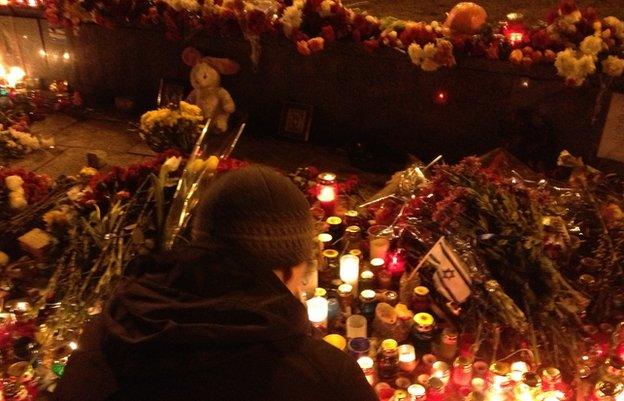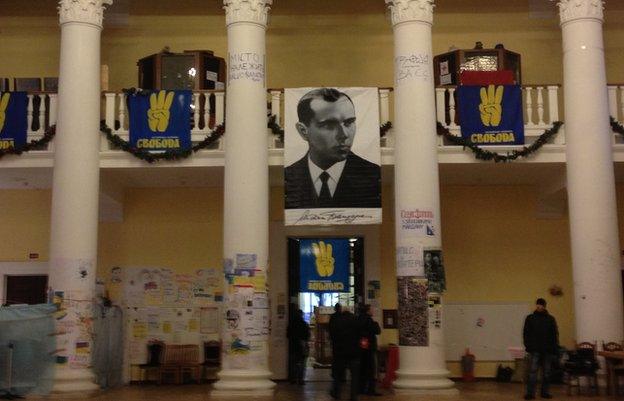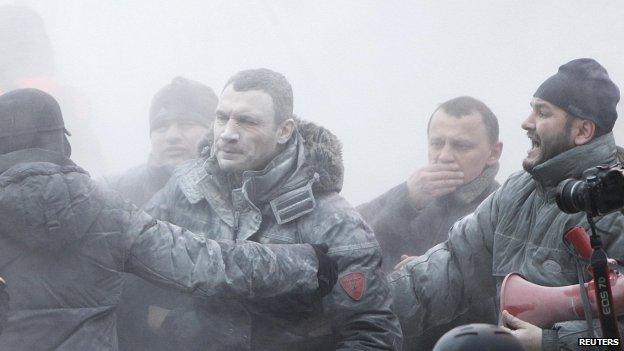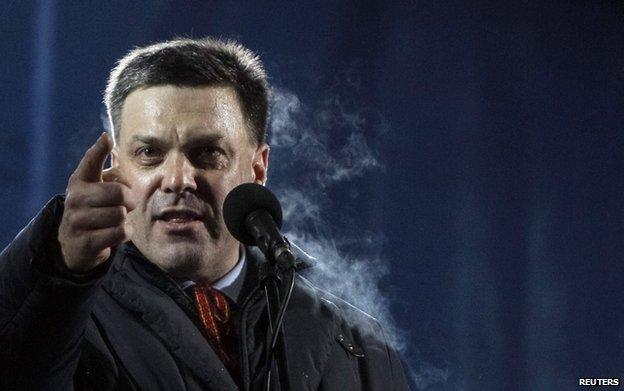Ukraine's revolution and the far right
- Published

Far right flags carried by activists outside Parliament in Kiev
Russia has labelled as fascists the new leaders in Ukraine and the protesters and opposition who toppled Viktor Yanukovych from power. BBC Kiev correspondent David Stern considers the importance of Ukraine's far right.
Amid the ocean of candles and flowers, at one of the dozens of shrines to dead anti-government protesters, shot during Kiev's horrific violence, there was a small plastic Israeli flag.
It was for Alexander Scherbatyuk, a Jewish-Ukrainian Afghan war veteran.

A shrine to victims who died in Independence Square
Inside the columned central hall of Kiev's city council, an activist base of operations, hung a giant banner with a Celtic cross, a symbol of "white power," and an American confederate flag.
Over the doorway was an immense portrait of Stepan Bandera, the Ukrainian nationalist partisan leader during World War Two, who at one point was allied with the Nazis.

Bandera's portrait in the Kiev city council building
These two images illustrate how complex and contradictory is the subject of the far right in Ukraine's mass protest movement, the Euromaidan.
Their role in ousting the president and establishing a new Euromaidan-led government should not be exaggerated.
But, as the second image shows, nor should their involvement be played down, especially now they have assumed key ministerial posts.
Euromaidan officials are not fascists, nor do fascists dominate the movement.
Contrary to some claims, ethnic Russians and Russian-speakers are not being attacked or under threat of violence. And anti-Semitism has played absolutely no role in the demonstrations and government.
Euromaidan has been a movement supported by just under half of Ukrainians according to a recent poll - representing a broad swathe of Ukrainian society: Russian and Ukrainian speakers; east and west; gay and straight; Christians, Muslims and Jews.
They united to remove Viktor Yanukovych and seem to be coming together again in the belief they need to defend Ukraine against Russia.

An anti-government protest in January in Kiev's Grushevsky street
The ultra-nationalists, and their extreme right fringe, are a small part of the overall campaign - a subgroup of a minority. They are concentrated primarily amid the tents, barricades and self-defence units of the Maidan, the shorthand term for the movement's core.
However, even though the far right are a minority, for their numbers they have played an outsized, though not decisive, role. What is more, at key points they have influenced the course of the demonstrations.
And, at times, they have appeared to be the driving force behind the Maidan - which has become an actor in the protests in its own right, alongside the political parties, the government and the Ukrainian population as a whole.
In January, I watched as young protesters launched an attack that led to the fighting on Kiev's Grushevsky Street. This turned into a protracted, blood-filled melee between riot police and protesters.
The masked, petrol bomb-wielding activists were joined by countless others, and scores of cheering supporters outraged at the government's growing brutality and draconian new anti-protest law.
Many were also ultra-nationalists or sympathisers but there was a large number who were not.
Euromaidan's political heads have at various points seemed unable, unwilling or even afraid to rein in the radical right, who are mostly concentrated in an umbrella organisation called Right Sector. "The extreme right, although a minority, was a highly effective minority. These can play out-of-proportion roles precisely in revolutions or similar situations," says Tarik Cyril Amar, a professor at Columbia University and expert on Ukraine.
Before the fighting broke out on Grushevsky Street, boxer-turned-politician Vitaly Klitschko tried to head off the violence. He was sprayed with a fire extinguisher, and the clashes erupted immediately, despite his pleas.

Vitaly Klitschko (centre) was attacked after calling for calm during the January protests
They also try to explain the extreme right away. Mr Klitschko and the other leaders blamed the fighting on "provocateurs", but then quickly dropped this line when it became obvious that the fighting was gaining traction among other activists.
Many Euromaidan supporters bristle at, or deny, any claim that the movement contains an influential ultra-nationalist element, fearful this will be used to tar the entire movement, which in fact is what has happened. They simply call them "patriots".
Their fears are fed by memory of Soviet-era propaganda, now being revived, that western Ukrainians are "Banderites" - followers of wartime partisan leader Stepan Bandera.
Bandera was, according to a number of Western and Ukrainian historians, a fascist or an "integral nationalist", which is something very close. The two organisations he led - the Organisation of Ukrainian Nationalists and the Ukrainian Insurgent Army (UPA) - are said to have engaged in atrocities against Poles, Jews, Russians and other Ukrainians.
Many on the Maidan, and beyond, are unaware of all that happened during the war, when millions of Ukrainians were starved, shot or deported by both the Nazis and the Soviets.
Bandera for them is nothing more than a symbol of national liberation and defence of Ukraine - which is partly true.
Their ubiquitous battle cry, "Hail Ukraine! Hail the heroes!", taken from the UPA, has now been largely stripped of its fascist and ethno-centric meaning.
Now it means simply what it says: Glory to Ukraine.
The far right was less of an issue when the protest movement was united in a single, unified mission. Now they are part of the government, in the form of the Svoboda (Freedom) party.

Svoboda leader Oleh Tyahnybok and other party members have been accused of anti-Semitism
In four years, Svoboda has gone from a fringe party - receiving less than 2% in presidential elections - to a major player in Ukrainian politics. Its members control six positions in the new government, including deputy prime minister, general prosecutor and defence.
But Svoboda members come in different shapes and sizes, with many people joining for its anti-corruption stance. Lately it has been toning down its nationalist rhetoric, in what may be an effort to go more mainstream. Moreover, it supports EU integration - an exception among Europe's far right.
Ultra-nationalist parties, such as France's National Front, are a fact of Europe's present political landscape. Take out the word "Ukrainian" and many of Svoboda's beliefs are widespread throughout the region and beyond. Especially in Russia.
That said, one of its parliamentary deputies has described the Holocaust as a "bright period" in European history. Its leader, Oleh Tyahnybok, has never disowned an earlier open letter he signed, saying world Jewry was taking over Ukraine and would commit genocide against Ukrainians. Their party platform strives to limit government positions according to ethnicity.
"[Svoboda's rise] is significant and not to be relativised away by quick guesses about its 'evolution'," said Professor Amar.
"There is perfectly no reason to down-talk Svoboda's extremism or danger."
Svoboda are not violent fascists and may change with time. But as Ukraine's crisis grows, and the far right helps patrol Kiev's streets in "self-defence units," they bear close watching. Very close.